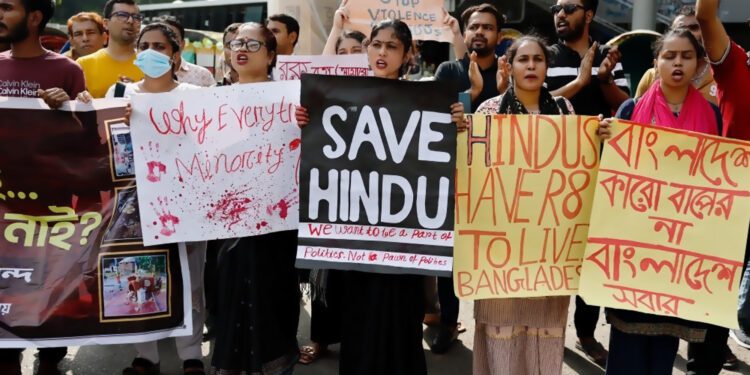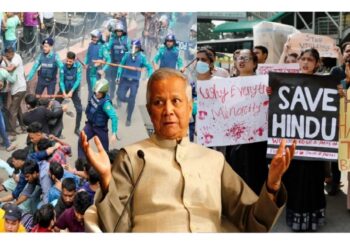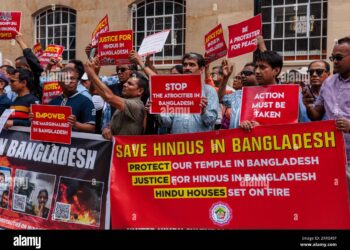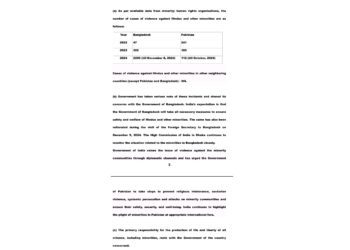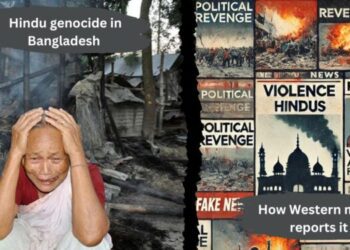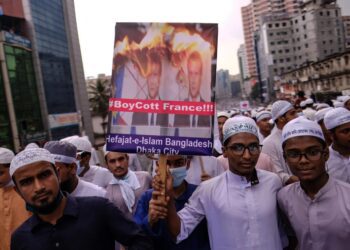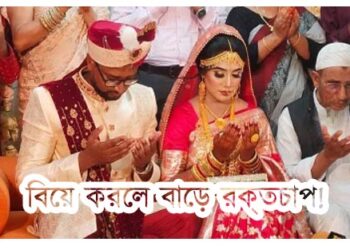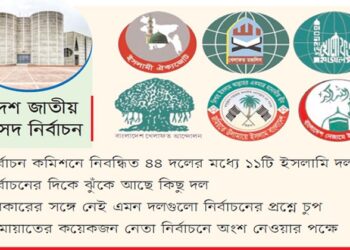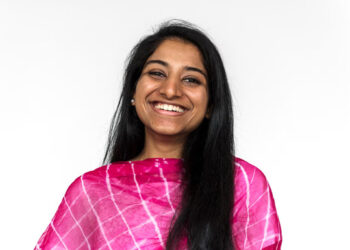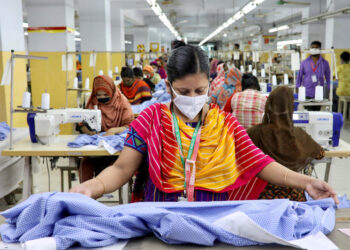Rati Agnihotri: How selective reporting and biased narratives shape global perceptions of the ongoing Hindu genocide in Bangladesh.
- Western media has glorified the Bangladesh crisis as a Gen Z Revolution and remains silent on the ongoing Hindu persecution in Bangladesh.
- The media reporting whitewashes the communal anti-Hindu violence in Bangladesh as isolated incidents targeting supporters of Sheikh Hasina and her party.
- Media ecosystems exaggerate the so-called “fake news” being circulated through social media in the context of ongoing attacks on Hindus in Bangladesh.
- It propagates anti-India propaganda in the garb of reporting on Bangladesh issue, with many media reports insinuating that India is perhaps playing a proactive role in peddling “fake news” exaggerating the scale of anti-Hindu violence in Bangladesh and that Indian Prime Minister Narendra Modi’s “Hindu” image has a lot to do with this “distortion.”
Hindudvesha, or systemic anti-Hindu hatred and prejudice, insidiously infiltrates various societal systems. The Western media, think tanks, and academic institutions laid the groundwork for the widespread internalization of Hindudvesha. As a result, a significant portion of civil society, including many within the Hindu community, has absorbed this prejudice to such an extent that it becomes nearly impossible to recognize the process at play. This self-perpetuating cycle of anti-Hindu sentiment continuously manifests across politics, culture, and society.
The most glaring manifestation of this suppression of Hindu suffering is evident in the global phenomenon of erasing Hindu issues from the media landscape. While distortion and biased portrayal might allow for some level of discourse and redressal, the Western media’s approach to Hindu issues often goes a step further by deliberately omitting news, reports, and analysis related to critical matters such as Hindu persecution and genocide.
For the audience, which often lacks direct access to these sites of oppression, the media serves as their primary source of information. When the so-called fourth estate of democracy acts as if Hindu persecution never occurred and dismisses any discussion of it as a fabrication by “Hindutva majoritarian” ideologues, the public gradually begins to internalize Hindudvesha. This leads to a disturbing dystopia where Hindus themselves start to shame fellow Hindus for raising Hindu issues in public forums.
In this article, we will discuss the media silencing of the cycle of violence and hatred perpetuated against the Hindu minority of Bangladesh in the aftermath of former Bangladeshi Prime Minister Sheikh Hasina’s ouster amidst massive student protests against a controversial plan that reserved high-paying government jobs for relatives of Bangladesh Independence War veterans.
Since the resignation and subsequent departure of Sheikh Hasina as Prime Minister of Bangladesh on August 5, 2024[1], the Hindu minority, which constitutes barely 7.5 percent of the country’s 170 million population, has faced a wave of violence and persecution. There has been a sharp rise in communal violence targeting Hindus, with reports of temples being vandalized and burned, homes and businesses attacked and destroyed, and numerous individuals assaulted. Tragically, Hindu women have also been subjected to sexual violence during this period of unrest.
The Bangladesh Hindu Buddhist Christian Oikya Parishad recently published a report highlighting 205 incidents of violence against minority communities, particularly Hindus, across 52 districts in Bangladesh following Sheikh Hasina’s departure. This report was made public in an open letter addressed to Muhammad Yunus, who assumed the role of Chief Adviser of Bangladesh’s interim government on August 8, 2024. The report underscores the widespread violence since Hasina’s ouster, noting multiple murders, assaults on women from minority communities, widespread hunger affecting thousands of families, and the destruction of numerous Hindu temples by fire. [2]
Glorification of Bangladesh crisis as Gen Z Revolution
The media has a major impact on how people view an issue. By choosing what to include or leave out, the media can amplify certain parts of a story while minimizing or entirely ignoring others. In recent Western media coverage of events in Bangladesh, there is a noticeable lack of reporting on the violence against Hindus and other minorities. Instead, there is a lot of focus on the “violent protests” in Bangladesh, which are portrayed as a progressive movement led by the country’s Gen Z.
“‘We’ve ousted this regime and will do so again’: the students bringing change to Bangladesh,” says The Guardian headline. “Gen Z Bangladeshis say their protests may have ended but their duty to the nation persists, inspiring older compatriots”, says the blurb. The write-up mentions in passing that there were reports saying that the homes and businesses of the minority Hindu population were being attacked along with the offices of the ruling Awami League Party. However, the article writer or the publication perhaps doesn’t deem Hindu lives worthy of further consideration; thus, the rest of the article doesn’t elaborate on the issue of minority persecution and sings paeans of praise for the “student revolutionaries “instead.[3]
The article doesn’t provide any details about the attacks on Hindu minorities in Bangladesh, but it does highlight how students are forming neighborhood groups in response to these attacks. While it rightly condemns the arrests and deaths of student leaders, it downplays the seriousness of the persecution of Hindu minorities. The article seems to suggest that the violence against Hindus is merely a side effect of an otherwise admirable student revolution.
“How Bangladesh’s students carried out the world’s first Gen Z revolution,” claims The Independent’s headline. The article follows the typical Western narrative, portraying the students of Bangladesh as leading the charge to overthrow the “authoritarian” Sheikh Hasina government.[4] The article romanticizes the incident where rioters stormed Sheikh Hasina’s luxurious official residence but remained silent about the violent and barbaric actions of the so-called “student revolutionaries.” These actions included publicly displaying Sheikh Hasina’s undergarments, shamelessly looting all her belongings, and viciously vandalizing the statue of Sheikh Mujibur Rehman, the founder of Bangladesh and Sheikh Hasina’s father.
As news of Sheikh Hasina’s ouster became public, the protestors in Dhaka climbed atop a large statue of Sheikh Mujibur Rehman and hammered the statue’s head with an axe. The vandalism of the statue was not just an act of hatred against Sheikh Hasina and her party but was, in fact, deeply rooted in Hinduphobia – the protestors were reportedly influenced by the anti-sculpture statements made by radical leaders. Thus, the act of violent hammering of the statue was a radical Islamic statement against the concept of “idol.” [5] But The Independent seems the least interested in reporting the seamier side of things. The article adopts an adulatory tone vis-à-vis the protestors, thus covertly justifying the loot, violence, vandalism, and perhaps even the anti-Hindu hatred: As she fled with her daughter and sister to India, protesters rejoiced in streets still stained by blood from violent clashes between students, the security forces, and counter-protesters from the ruling party Awami League student wing. [6]
One might wonder if the tone of this write-up would be the same if a similar “student revolution” had occurred in a Western country with such violence inflicted on its people. In all likelihood, the Western media would have taken a radically different stance, condemning the violence as an “onslaught on democracy.” However, the irony is glaring—in the case of a “third world” country like Bangladesh, unrestrained violence is instead framed as a “student revolution,” while the targeted attacks on Hindu minorities, driven by a dangerous radical Islamist ideology, are conveniently whitewashed by the Western media ecosystem.
Numerous such articles have been published in the Western press in the aftermath of the student protests in Bangladesh. “Students toppled the prime minister, but what next for Bangladesh?”, reads the headline of an article published by Open Democracy. [7] “How Gen Z women and military transformed Bangladesh”, says the Digital Journal headline.[8] “Who is Nahid Islam, student leader of campaign to oust PM Sheikh Hasina?”, says the Reuters headline.[9] “Bangladesh’s ‘Gen Z Revolution’ toppled a veteran leader. Why did they hit the streets and what happens now?”, says the CNN headline. [10]
In addition to the blatant glorification of alarmingly violent protests—initially student-led but likely later hijacked by radical Islamic extremists—these Western media reports share another troubling characteristic: the deliberate omission of news regarding the violence inflicted on Hindu minorities in Bangladesh. The Hindu community bore the brunt of the attacks following the ouster of former Prime Minister Sheikh Hasina. While Western media focuses on romanticizing the so-called “student revolution” in the aftermath of these protests, they remain conspicuously silent on the persecution of Hindus that escalated during the same period. Remarkably, even Bangladeshi media objectively reported on the attacks against Hindu minorities, yet the Western media, for reasons unknown, chose to ignore this critical aspect of the story.
Anti-Hindu Pogroms Portrayed as ‘Political Backlash’
As noted in the last section, the Western media has mostly skipped reporting on the ongoing Hindu persecution in Bangladesh. But when media publications report on anti-Hindu atrocities, the communal attacks on Hindu minorities are portrayed as isolated incidents of attacks on the supporters of Sheikh Hasina’s party, Awami League.
A few days ago, the New York Times carried a story on the Hindu persecution in Bangladesh, with an eyebrow-raising “Hindus in Bangladesh Face Revenge Attacks After Prime Minister’s Exit,” positioning the anti-Hindu pogrom as revenge attacks. However, they reportedly changed the headline after facing severe backlash on social media.[11]
The publication changed the headline to “Hindus in Bangladesh Face Attacks After Prime Minister’s Exit”. Economist and writer Sanjeev Sanyal commented on the previous headline and provided a screenshot through his X account. “So NYT suggests that attacks on Hindus are “revenge” …In other words, they must have done something bad to start it and needed to be avenged”, he wrote.[12]
The headline change notwithstanding, The NYT story does quite a hit job of whitewashing the ongoing anti-Hindu pogrom in Bangladesh. The article blurb prejudices the reader at the outset against Hindus in Bangladesh and preemptively tries to kill any sympathy that the reader might otherwise feel for them. “There has long been a perception that the Hindu minority supports Sheikh Hasina, who resigned her post and fled the country after a popular uprising,” says the blurb.
The article repeatedly highlights that, alongside the offices of the Awami League and the homes of its members, the homes of those perceived as Sheikh Hasina’s allies, “including the Hindu minority,” were attacked by protesters. This narrative blatantly justifies the persecution of Hindus in Bangladesh by suggesting that the violence against them is a consequence of their alleged support for Sheikh Hasina’s party, effectively rationalizing the ongoing atrocities.[13]
To anyone even remotely familiar with the situation in Bangladesh, this spurious argument is nothing short of a farce. The Hindu minority community in Bangladesh has been systematically targeted and massacred since the country’s inception. While Sheikh Hasina was perceived as somewhat “secular” and “pro-minority” compared to the radical Bangladesh Islamist Party and its ally Jamaat-e-Islami, numerous incidents of attacks on Hindus and the vandalism of Hindu temples still occurred during her tenure. Thus, the claim that the Hindu minority in Bangladesh is now facing attacks because of their supposed support for Sheikh Hasina’s party is outright laughable.
Furthermore, the Western media is setting a dangerous precedent by implicitly justifying the violent assaults on supporters of Sheikh Hasina and her party. It is ironic that the West, which self-righteously positions itself as the guardian of democracy and minority rights worldwide, is openly propagating a narrow, partisan viewpoint that excuses brutal attacks on political party supporters in a foreign country. This entire narrative is not only absurd but also exposes the deep hypocrisy and hollowness of the Western media ecosystem.
“Nobel laureate Muhammad Yunus urges peace as he is sworn in as Bangladesh leader, ” reads the headline of another recently published article by The Guardian. The piece mentions the issue of attacks on Hindu minorities in Bangladesh in passing but, again, tries to link these attacks to the apparent status of Bangladeshi Hindus as supporters of Sheikh Hasina’s party. “There are more than 13 million Hindus in Bangladesh – almost 8% of the population, which is predominantly Muslim – and many are traditionally supporters of Hasina’s party, the Awami League”, says the write-up. [14]
The article emphasizes that “Muslims stood side by side with their Hindu neighbors to protect a Hindu temple from a violent mob,” [15] highlighting this singular example of solidarity as a focal point in social media narratives. This isolated incident, where Muslims in Bangladesh apparently formed a protective wall around Hindu temples, has been widely circulated on social media and is being used to counter the overwhelming evidence of the ongoing persecution of Hindus in the country.
It appears that the Western media is echoing this social media narrative, focusing more on portraying Muslims in Bangladesh as altruistic protectors of Hindu homes and temples rather than providing a realistic account of the dire situation affecting Hindus on the ground. One would expect tangible changes at the grassroots level if this portrayal were accurate. Yet, there is no evidence of such change. No prominent “Muslim youth leader” from Bangladesh has publicly and unequivocally condemned the ongoing anti-Hindu pogrom. Instead, the harrowing tales of abuse and torture of Hindu families continue to surface, raising serious questions about the narrative being pushed by both social media and the Western media.
Even the typically neutral Reuters news report seems compelled to stress that the minority Hindu community in Bangladesh are supporters of Hasina’s Awami League. The headline, “Hundreds Protest in Dhaka Over Violence Against Hindus in Bangladesh,” initially suggests a straightforward, factual account of the situation. However, the report quickly inserts a seemingly unnecessary detail, stating, “Hindus, who make up about 8% of Bangladesh’s population of 170 million, have traditionally supported Hasina’s Awami League party, which sparked people’s anger after violent clashes between anti-quota protesters and security forces last month.”
This insertion subtly shifts the narrative, implying a connection between the Hindu community’s political affiliations and the violence they are experiencing. By doing so, the report essentially justifies the attacks, suggesting that the anger against Hindus is a consequence of their perceived political support. This emphasis detracts from the main issue—violence against a vulnerable minority—and instead redirects focus to their supposed political alignment, which, in this context, risks excusing or rationalizing the persecution they face.[16]
The patterns in Western media coverage of the situation in Bangladesh reveal a disturbingly uniform global narrative that perpetuates Hinduphobia on a mass scale. In the case of the persecution of the minority Hindu community in Bangladesh, both mainstream media and social media propagate the same narrative, framing the targeted communal violence as isolated incidents directed at supporters of Sheikh Hasina’s political party. The parallels between the arguments advanced by the Western media and those by Islamist social media accounts that whitewash the pogrom are striking.
This alignment suggests that Hindudvesha, or anti-Hindu hatred, is far from a random or isolated phenomenon. Instead, it is a systematic discourse meticulously manufactured and perpetuated through a network of interconnected systems. These systems, encompassing both media and social platforms, work in tandem to downplay or justify the violence against Hindus, reinforcing a broader narrative that undermines the gravity of their persecution.
Gaslighting anti-Hindu violence as “online misinformation “
While the Western media is visibly averse to covering the ongoing persecution of Hindus in Bangladesh, it takes a special interest in warning readers about possible “fake news” circulating on social media regarding these attacks. This emphasis suggests that the media is more invested in refuting the narrative of Hindu persecution than in providing serious, on-the-ground coverage of the situation.
A prime example is the France 24 headline, “Attacks and Online Misinformation Frighten Bangladesh Hindus.” While the story ostensibly addresses the ongoing attacks on Hindus, it subtly discredits the severity of the issue from the outset by insinuating that rampant misinformation is contributing to the panic among Bangladeshi Hindus. The opening lines state, “Those fears, however justified, are being turbocharged by a wave of false rumors of other, deadly attacks being spread online and amplified by the media in Hindu-majority neighbor India.” [17]
In doing so, the article pushes the narrative that Hindu-majority India is perhaps spreading misinformation about the attacks on Hindus in Bangladesh, thereby sidelining the real issue of anti-Hindu violence. This approach shifts the focus away from the persecution itself and instead questions the validity of the reports, creating doubt and downplaying the severity of the situation. This is a clear example of journalism at its most unethical—or perhaps more accurately, at its most ethically compromised.
How often do you see such news reports when the victims are Muslims in different parts of the world? In such cases, the media tends to provide sensitive, pro-victim coverage, sometimes even exaggerating the extent of their victimhood. However, when the victims are defenseless Hindus, the same media seems eager to grab any available justification to suggest that these Hindus somehow brought the violence upon themselves.
The France 24 report further claims that false reports of anti-Hindu attacks in Bangladesh were being circulated online, supposedly exaggerating the scale of the violence. Yet, the article offers little concrete evidence to substantiate its claims of “fake news.” Instead, it relies on generic, unsubstantiated statements, merely mentioning that many of these alleged “fake news” posts originated from social media users in India, a country whose Prime Minister, Narendra Modi, is described as an “unabashed champion of the Hindu faith” and a staunch supporter of Hasina’s rule.[18]
The report covertly but shamelessly shifts the blame for the anti-Hindu pogrom in Bangladesh onto the Indian Prime Minister, suggesting that his strong Hindu identity supposedly makes Indians prejudiced against Muslims, leading them to circulate false social media posts exaggerating the scale of anti-Hindu violence in Bangladesh.
The only example of fake news that the France 24 report provides is an X post from India, which it claims falsely reported that 500 Hindus had been killed in Bangladesh, hundreds of Hindu women raped, and dozens of Hindu temples burned down. However, the report does not even share a screenshot of the alleged X post in Hindi. This omission raises doubts about the authenticity of the claims made by France 24, especially since no evidence is provided to support their assertions. Or perhaps the fact that it comes from France 24 exempts it from scrutiny?
Even if one accepts the possibility that such social media posts were being circulated, the estimate of 500 killings is, by most standards, rather modest. Given the complete breakdown of law and order in Bangladesh, including the collapse of the police machinery, there is no reliable way to ascertain the actual scale of the violence or the number of casualties. With no police presence to protect citizens, Hindus currently have no mechanism to file FIRs or seek legal recourse.
In such a scenario, social media becomes the primary source of information, with many Hindu advocacy groups sharing first-hand reports from people on the ground in Bangladesh. Naturally, some fake news might circulate as well, but that does not give the Western media the right to act as judge and jury, dismissing all social media posts detailing attacks on Bangladeshi Hindus as ‘fake news.’ Temples have been burned, and many Hindu women have been raped—there is simply no way to determine the exact numbers. So, who gets to decide what is fake and authentic news?
Several Indian media publications have also jumped onto the bandwagon and are busy highlighting so-called “fake news” being circulated in the context of ongoing anti-Hindu violence in Bangladesh. The Business Standard talks about BBC Bangla’s verification of many social media posts on the persecution of Hindus in Bangladesh and further claims that the BBC Bangla analysis found many of these posts fake and discovered that many of these social media posts originated from India.
“The BBC’s fact-checking division, BBC Verify, investigated several posts that spread on social media. It found that while some attacks on minorities did occur after the fall of Sheikh Hasina’s government, many of these attacks were exaggerated or fabricated”, says the piece.[19]
A recent article published by The Wire makes similar claims of fake news being circulated in the context of the ongoing persecution of Hindus in Bangladesh and attributes this discovery to a fact check by German broadcaster Deutsche Welle (DW). “Fact Check: False Claims on Violence in Bangladesh Go Viral,” reads the headline. [20]
Another piece by Anadolu Agency makes similar claims. “Political, not communal: Misinformation runs rife in India over attacks on Hindus in Bangladesh,” reads the headline. The write-up goes a step further and accuses Indian media outlets of falsely portraying the violence against Hindus in Bangladesh as religiously motivated. [21]Thus, the write-up blatantly attacks and intimidates Indian media, denying them even the basic right to do their own analysis and form their own opinions!
Al Jazeera goes even further in its vicious propaganda. ‘Islamophobic, alarmist: How some India outlets covered Bangladesh crisis”, reads the headline.[22] That’s quite a leap of logic! It means that anyone who criticizes acts of terror or violence being perpetuated by people who practice Islam is essentially an Islamophobic. Thus, by extension, it implies that no one can criticize anything that is done by a Muslim or in the name of Islam!
Conclusion
It cannot be emphasized enough how the entire ecosystem of media, popular culture, and academia works in unison to negate the lived traumas and struggles of Hindus. India’s very own Bollywood celebrities, whose hearts skip a beat whenever something happens in faraway lands like Gaza or Ukraine, remain conspicuously indifferent to the cold-blooded mass persecution of Hindus happening right in their own backyard.
For example, the “All Eyes on Rafah” hashtag condemning Israel’s actions in Rafah in May 2024 was widely shared across social media by nearly all prominent Bollywood celebrities, along with many lesser-known figures. However, when it comes to condemning the attacks on Hindu minorities in Bangladesh, only three Bollywood celebrities—Preity Zinta, Raveena Tandon, and Indian television actress Hina Khan—have spoken out. Only Hina Khan has specifically mentioned the word “Hindus” in her post. This stark contrast reveals the deep-rooted Hinduphobia within the popular culture machinery, where even celebrities shy away from directly addressing Hindu issues, fearing potential backlash.
How do we change this dire situation? There are no easy answers. However, a crucial first step is for each of us to play our part in decoding and unraveling the layers of Hindudvesha that permeate global politics, culture, and civil society. We can hope to effect meaningful change only by confronting and addressing this pervasive bias.
Citations
[1] Bangladesh Hindus were attacked in ‘revenge’, screams New York Times header, changes it after furor – South Asia News; https://www.wionews.com/south-asia/bangladesh-hindus-were-attacked-in-revenge-screams-new-york-times-header-changes-it-after-furore-748268
[2] 205 incidents of persecution of Hindus and other minorities since August 5: Bangladesh Hindu Buddhist Council Oikya Parishad; https://www.opindia.com/2024/08/205-incidents-of-persecution-of-hindus-other-minorities-since-aug-5-bangladesh-hindu-buddhist-council/
[3] ‘We’ve ousted this regime and will do so again’: the students bringing change to Bangladesh | Global development | The Guardian; https://www.theguardian.com/global-development/article/2024/aug/07/bangladesh-gen-z-revolution-students-protest-change-sheikh-hasina-awami-dhaka
[4] How Bangladesh’s students carried out world’s first Gen Z revolution | The Independent; https://www.independent.co.uk/asia/south-asia/bangladesh-protesters-gen-z-sheikh-hasina-overthrown-b2591824.html
[5] Bangladesh protestors attack the nation’s founding heritage: How Pakistan went down the same path to erase its own past; https://www.opindia.com/2024/08/bangabandhu-museum-destroyed-sheikh-mujibur-rehmans-residence-burned-to-ashes-islamists-bangladesh-are-wiping-out-nations-history/
[6] How Bangladesh’s students carried out world’s first Gen Z Revolution | The Independent; https://www.independent.co.uk/asia/south-asia/bangladesh-protesters-gen-z-sheikh-hasina-overthrown-b2591824.html
[7] Bangladesh student protests topple PM: What now? | openDemocracy; https://www.opendemocracy.net/en/students-protests-revolution-prime-minister-sheikh-hasina-bangladesh/
[8] How Gen Z women and the military transformed Bangladesh – Digital Journal; https://www.digitaljournal.com/world/how-gen-z-women-and-the-military-transformed-bangladesh/article
[9] Who is Nahid Islam, student leader of campaign to oust PM Sheikh Hasina | Reuters; https://www.reuters.com/world/asia-pacific/soft-spoken-sociology-student-led-campaign-oust-bangladeshs-hasina-2024-08-06/
[10] Bangladesh ‘Gen Z revolution’ toppled PM Sheikh Hasina. Why did they hit the streets and what happens now? | CNN; https://edition.cnn.com/2024/08/06/asia/bangladesh-protests-hasina-resignation-explainer-intl-hnk/index.html
[11] NYT calls violence against Hindus in Bangladesh ‘revenge attacks’: How Western media gets the India story wrong – Firstpost; https://www.firstpost.com/explainers/nyt-violence-against-hindus-bangladesh-revenge-attacks-how-western-media-gets-the-india-story-wrong-13802799.html
[12] Sanjeev Sanyal on X; https://x.com/sanjeevsanyal/status/1821392342051418614?ref_src=twsrc%5Etfw%7Ctwcamp%5Etweetembed%7Ctwterm%5E1821392342051418614%7Ctwgr%5Efab62d854820bd0554e6406296650d41d2329f34%7Ctwcon%5Es1_&ref_url=https%3A%2F%2Fwww.firstpost.com%2Fexplainers%2Fnyt-violence-against-hindus-bangladesh-revenge-attacks-how-western-media-gets-the-india-story-wrong-13802799.html
[13] Hindus in Bangladesh Face Revenge Attacks After Hasina’s Ouster | The New York Times; https://www.nytimes.com/2024/08/07/world/asia/bangladesh-politics-unrest.html
[14] Nobel laureate Muhammad Yunus urges peace as he is sworn in as Bangladesh leader | Bangladesh | The Guardian; https://www.theguardian.com/world/article/2024/aug/07/nobel-laureate-muhammad-yunus-urges-peace-ahead-of-return-to-bangladesh
[15] Ibid
[16] Hundreds protest in Dhaka over violence against Hindus in Bangladesh | Reuters; https://www.reuters.com/world/asia-pacific/hundreds-protest-dhaka-over-violence-against-hindus-bangladesh-2024-08-09/
[17] Attacks and online misinformation frighten Bangladeshi Hindus; https://www.france24.com/en/live-news/20240811-attacks-and-online-misinformation-frighten-bangladeshi-hindus
[18] Ibid
[19] ‘Persecution’ of Hindus in Bangladesh: Fake posts uncovered by BBC | The Business Standard; https://www.tbsnews.net/bangladesh/persecution-hindus-bangladesh-fake-posts-uncovered-bbc-914141
[20] The Wire: The Wire News India, Latest News, News from India, Latest News, News from India, Politics, External Affairs, Science, Economics, Gender and Culture; https://thewire.in/south-asia/fact-check-bangladesh-violence-false-claims
[21] Political, not communal: Misinformation runs rife in India over attacks on Hindus in Bangladesh; https://www.aa.com.tr/en/asia-pacific/political-not-communal-misinformation-runs-rife-in-india-over-attacks-on-hindus-in-bangladesh/3300650
[22] ‘Islamophobic, alarmist’: How some India outlets covered Bangladesh crisis | Media News | Al Jazeera; https://www.aljazeera.com/news/2024/8/8/islamophobic-alarmist-how-some-india-outlets-covered-bangladesh-crisis

